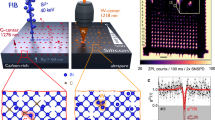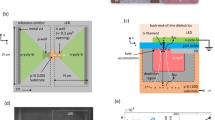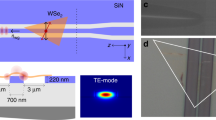Abstract
There is an urgent requirement for an optical emitter that is compatible with standard, silicon-based ultra-large-scale integration (ULSI) technology1. Bulk silicon has an indirect energy bandgap and is therefore highly inefficient as a light source, necessitating the use of other materials for the optical emitters. However, the introduction of these materials is usually incompatible with the strict processing requirements of existing ULSI technologies. Moreover, as the length scale of the devices decreases, electrons will spend increasingly more of their time in the connections between components; this interconnectivity problem could restrict further increases in computer chip processing power and speed in as little as five years. Many efforts have therefore been directed, with varying degrees of success, to engineering silicon-based materials that are efficient light emitters2,3,4,5,6,7. Here, we describe the fabrication, using standard silicon processing techniques, of a silicon light-emitting diode (LED) that operates efficiently at room temperature. Boron is implanted into silicon both as a dopant to form a p–n junction, as well as a means of introducing dislocation loops. The dislocation loops introduce a local strain field, which modifies the band structure and provides spatial confinement of the charge carriers. It is this spatial confinement which allows room-temperature electroluminescence at the band-edge. This device strategy is highly compatible with ULSI technology, as boron ion implantation is already used as a standard method for the fabrication of silicon devices.
This is a preview of subscription content, access via your institution
Access options
Subscribe to this journal
Receive 51 print issues and online access
$199.00 per year
only $3.90 per issue
Buy this article
- Purchase on Springer Link
- Instant access to full article PDF
Prices may be subject to local taxes which are calculated during checkout




Similar content being viewed by others
References
European Commission Technology Roadmap—Optoelectronic Interconnects for Integrated Circuits (eds Forchel, A. & Malinverni, P.) (Office for Official Publications of the European Communities, Luxembourg, 1998).
Hirschman, K. D., Tysbekov, L., Duttagupta, S. P. & Fauchet, P. M. Silicon-based visible light-emitting devices integrated into microelectronic circuits. Nature 384, 338–341 (1996).
Lu, Z. H., Lockwood, D. J. & Baribeau, J.-M. Quantum confinement and light emission in SiO2/Si superlattices. Nature 378, 258–260 (1995).
Komoda, T. et al. Visible photoluminescence at room temperature from microcrystalline silicon precipitates in SiO2 formed by ion implantation. Nucl. Instrum. Methods B 96, 387–391 (1995).
Zheng, B. et al. Room-temperature sharp line electroluminescence at λ = 1.54 µm from an erbium-doped, silicon light-emitting diode. Appl. Phys. Lett. 64, 2842–2844 (1994).
Vescan, L. & Stoica, T. Room-temperature SiGe light-emitting diodes. J. Luminescence 80, 485–489 (1999).
Leong, D., Harry, M., Reeson, K. J. & Homewood, K. P. A silicon/iron disilicide light-emitting diode operating at a wavelength of 1.5 µm. Nature 387, 686–688 (1997).
Tybeskov, L., Moore, K. L., Hall, D. G. & Fauchet, P. M. Intrinsic band-edge photoluminescence from silicon clusters at room temperature. Phys. Rev. B 54, R8361–R8364 (1996).
Sveinbjörnsson, E. O. & Weber, J. Room temperature electroluminescence from dislocation rich silicon. Appl. Phys. Lett. 69, 2686–2688 (1996).
Hirth, J. P. & Lothe, J. Theory of Dislocations 2nd edn, 63 (John Wiley & Sons, New York, 1982).
Author information
Authors and Affiliations
Corresponding author
Rights and permissions
About this article
Cite this article
Ng, W., Lourenço, M., Gwilliam, R. et al. An efficient room-temperature silicon-based light-emitting diode. Nature 410, 192–194 (2001). https://doi.org/10.1038/35065571
Received:
Accepted:
Issue Date:
DOI: https://doi.org/10.1038/35065571
This article is cited by
-
Edge Electronic States and Direct Bandgap in Si Nanostructures on Silicon Oxide
Transactions on Electrical and Electronic Materials (2024)
-
A sub-wavelength Si LED integrated in a CMOS platform
Nature Communications (2023)
-
Enhanced Photoluminescence of Tb3+ Ions Ce3+ Ions and SnO2 Nanocrystals Co-doped Silica Thin Films
Optical and Quantum Electronics (2022)
-
Towards integrated tunable all-silicon free-electron light sources
Nature Communications (2019)
-
Nanomachining-enabled strain manipulation of magnetic anisotropy in the free-standing GaMnAs nanostructures
Scientific Reports (2019)
Comments
By submitting a comment you agree to abide by our Terms and Community Guidelines. If you find something abusive or that does not comply with our terms or guidelines please flag it as inappropriate.



